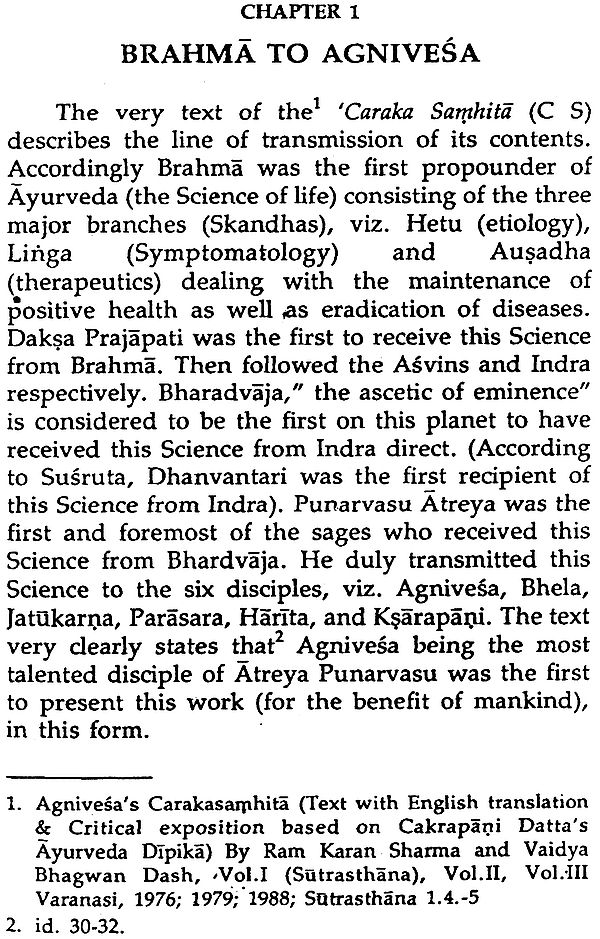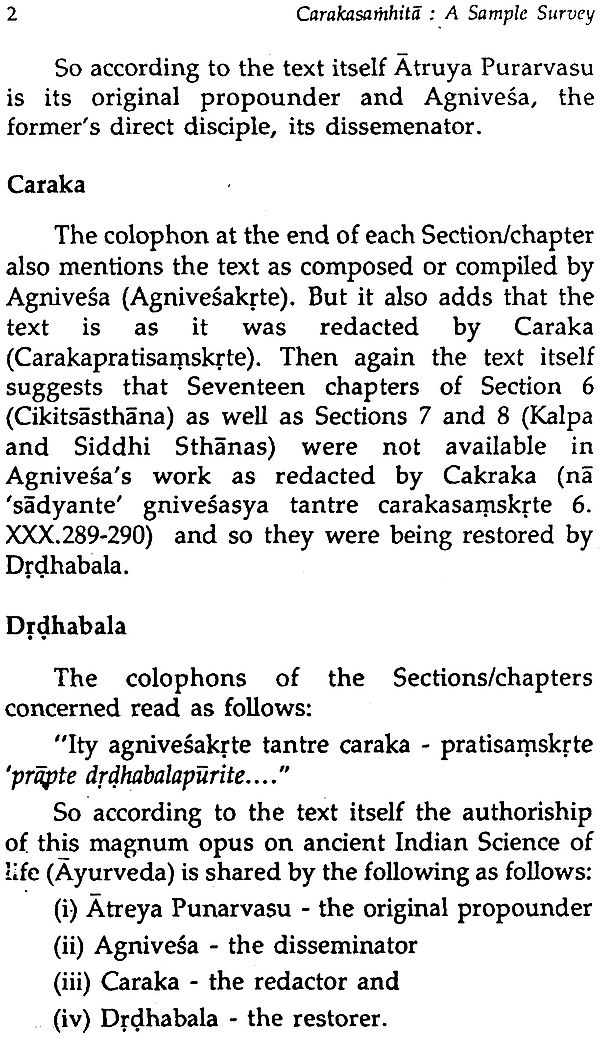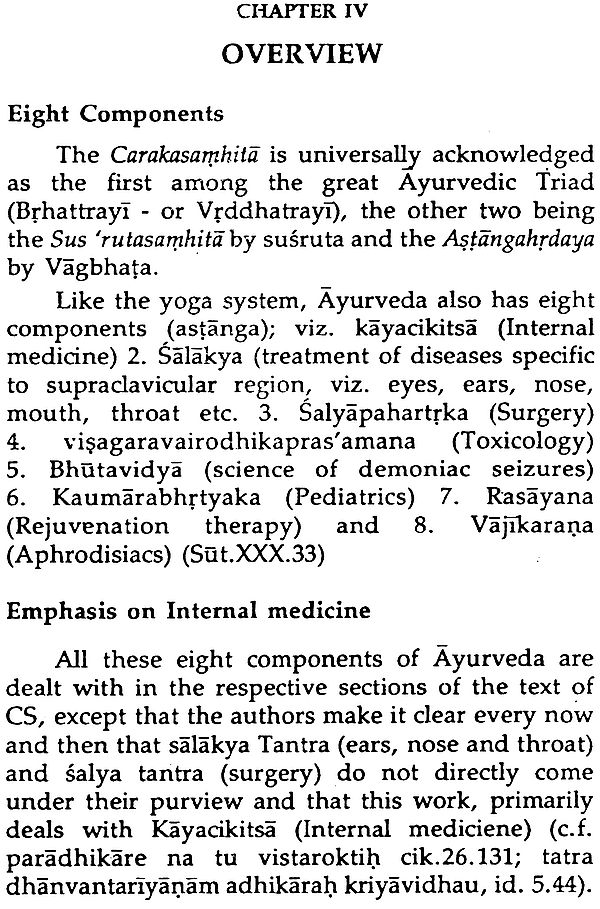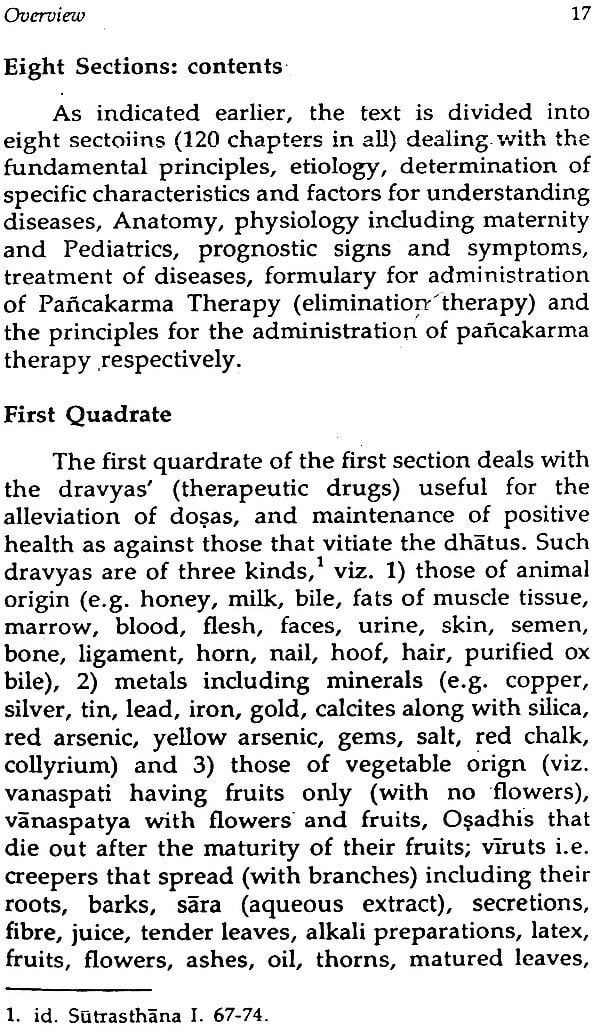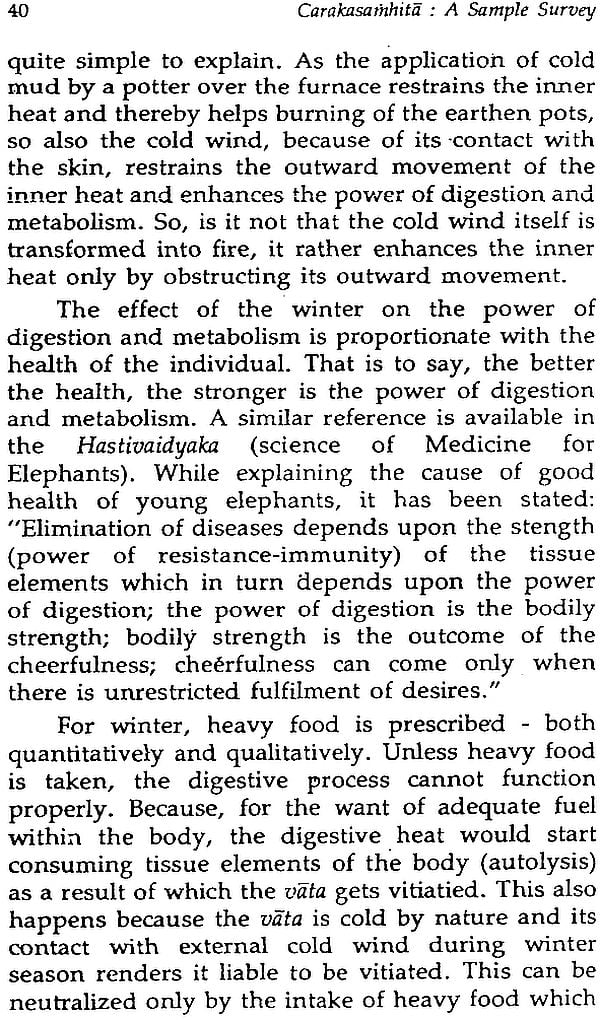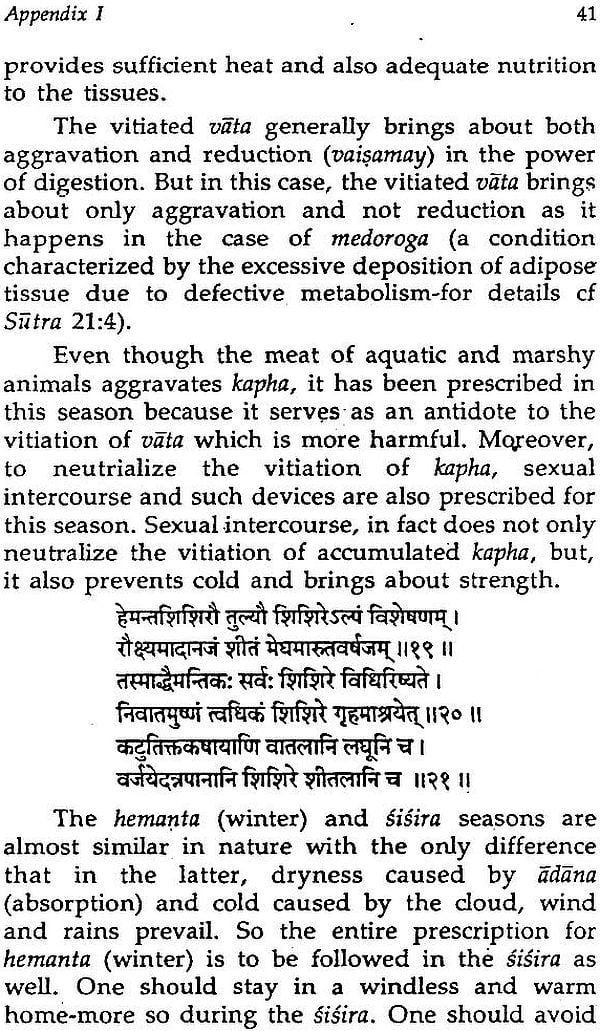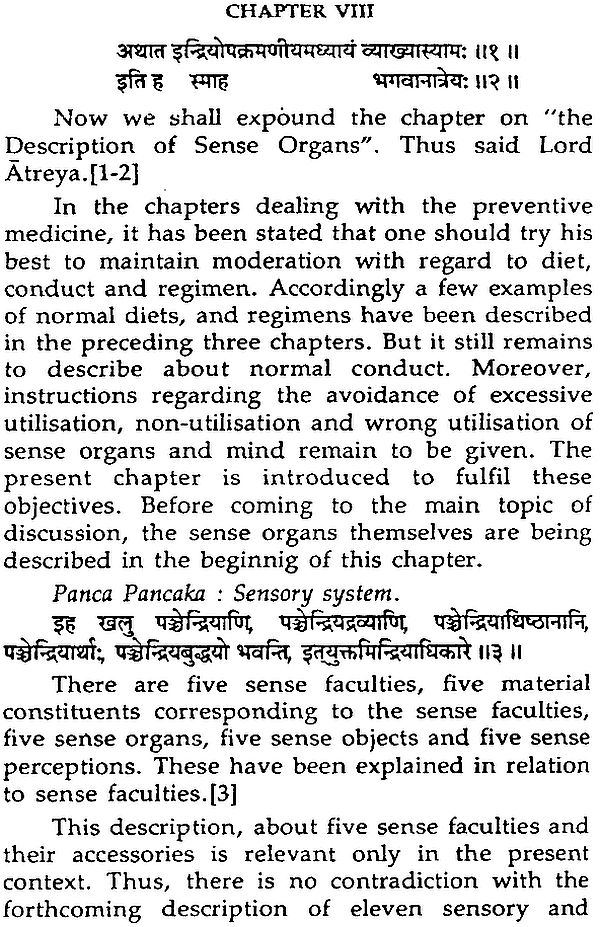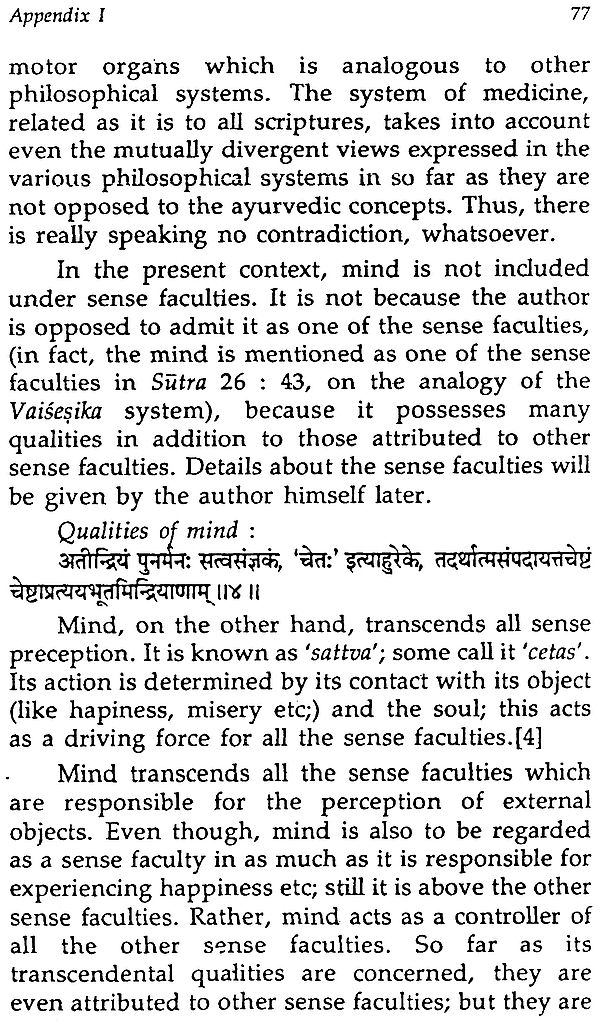
Carakasamhita: A Sample Survey
Book Specification
| Item Code: | IHL426 |
| Author: | Ram Karan Sharma |
| Publisher: | Rashtriya Sanskrit Sansthan, Janakpuri |
| Language: | English |
| Edition: | 2015 |
| Pages: | 106 |
| Cover: | Hardcover |
| Other Details | 8.8 inch X 5.8 inch |
| Weight | 250 gm |
Book Description
From the Jacket
The monograph represents a brief overview of the Caraka Samhita - the oldest ancient Indian record on Ayurveda - the Science of living a long, healthy and happy life.
An attempt is made to present some of the basic concepts of Ayurveda, aimed at the A maintenance of positive health and prevention and cure of physical and mental ailments.
The presentation is faithful to the words of the original text and its Ayurvedadipika commentary. So relevant chapters on Dietetics, Non-suppression of natural urges and svasthavrtta are also fully reproduced in order to acquaint the esteemed readers with the holistic philosophy of Health care underlying Ayurvedic precepts preserved in the oral tradition, as recorded in the text itself.
Ram Karan Sharma, (born if March 20, 1927) was initiated - to Vedic and allied studies (including Ayurveda) on traditional lines by Pandit Ambikadatta Sharma, at Lokamanya Brahmacaryasrama, Muzaffarpur (Bihar). As a fulbright scholar, he worked with Prof. M.B. Emeneau, at the University of California, Berkeley.
He has all along been making distinct contributions to, promotion of Sanskrit Studies in all its aspects, as a teacher, educational administrator, and a writer. Areas A of his special interest are: Panini, Maha-• (bharata, Darsana, Kavya and. Ayurveda. His creative writings in Sanskrit, include Sandhya (poetry), a recipient of Sahitya Akademi’s award and Sima (a novel) a recipient of Bharatiya Bhasha Parishad award. More than one hundred research papers and about a dozen major publications, he has authored. He A has been working on the Caraka Samhita (English translation of the text and critical exposition based on Cakrapanidatta’s Ayurvedadipika) with Vaidya (Bhagwan Dash as a co-author since 1963.
He was Founder Director, Rashtriya Sanskrit Sansthan. Presently he is the President of International Association of Sanskrit Studies.
Foreword
I have great pleasure to present this volume of Silver Jubilee Publication Series of the Rashtriya Sanskrit Sansthan to our esteemed readers. The Volume varily represents the goodwill and cooperation, the Sansthan has all along been receiving from the distinguished scholars all over the country.
The Sansthan was established in October, 1970 as an autonomous apex body under the Ministry of 2 Human Resource Development, Govt. of India with a view to promoting, preserving and propagating Sanskrit learning in all its aspects, with special reference to the indepth shastraic learning. Apart from conducting the regular courses of studies at the various constituent Vidyapeethas, it has been bringing out invaluable publications representing dissemination of knowledge’ contained - in the Shastras.
Thanks to the continued help, encouragement and support from the Ministry of Human Resource Development, Govt. of: India that the Sansthan has grown by leaps and bounds and has been able to render its services to promotion of Sanskrit learning at national and international. levels and is now completing its 25th year. It is quite in the fitness of things that the General Body of the Sansthan decided to bring out 25 scholarly monographs in commomeration of the Silver Jubilee year of Sansthan.
The present volume, as its very title suggests, is a brief overview of the Caraka Samhita, the oldest - available text of Ayurveda, The volume speaks for itself. The learned author happens to be the founder Director of the Sansthan and has been awarded the Certificate of Honour by the Hon’ble President of India for his deep scholarship in Sanskrit. He is presently the President of the International Association for Sanskrit Studies. As he has rightly mentioned in his preface, Ayurveda constitutes an integral part of Sanskrit tradition. There is a need to create awareness about Ayurveda among scholars in general and Sanskritists in particular. It is hoped that this volume will go a long way towards creating such an awareness and also familiarizing the general readers with some of the fundamental principles of Ayurveda relating to Dietetics and other healthy regimens. The Sansthan is already grateful to Dr. R.K. Sharma for his pioneering services from its very inception. I have no words to express the deep sense of gratitude for all his invaluable services, specially with regard to the Silver Jubilee Celebrations of the Sansthan.
I shall be failing in my duties, if I do not mention the services rendered by my colleagues at the various levels, specially Dr. Savita Pathak and Dr. R. Devanathan who have been working day and night for planning and organizing the various programmes connected with the Silver Jubilee Celebrations, particularly the. Publications of the Silver Jubilee series. M/s Nag Publishers deserve our thanks for bringing I out this monograph on time at a very short notice
Preface
I have great pleasure in presenting this humble sample survey of the Caraka Samhita, the oldest ancient Indian record on Ayurveda (the Science of Life) available with us, to our esteemed readers.
To my mind, Sanskrit and Ayurveda go together. Of late, a wide gap has developed between the two. It is high time that efforts are made to remove the gap in the interest of our great Holistic philosophy contained in the great Vedic Tradition. This humble presentation represents such an attempt in that direction.
I have tried my best to be faithful to the original text so that general readers, not acquainted with the Ayurvedic tradition, may have a first hand account of some of the basic Ayurvedic concepts. It is with this end in view that relevant chapters on Dietetics, Non-Suppression of natural urges and Healthy Regimens are also reproduced at Appendix I. A fraction of this sample survey was presented by me at a Seminar meeting of the Department of South Asian Studies, University of Chicago in 1989. The same has been further elaborated. I am grateful to the authorities of the Rastriya Sanskrit Sansthan for the inclusion of this work under their Silver Jubilee Monograph Series. . Heartiest congratulations to all my colleagues of the Sansthan. On their successful completion of the twenty five glorious years of meritorious services!
| Dedication | ||
| Preface | i | |
| Chapter I | Brahma to Agnivesa | 1 |
| Chapter II | Credibility of the Text | 7 |
| Chapter III | Foundation | 9 |
| Chapter IV | Overview | 16 |
| Chapter V | Conspectus | 27 |
| Appendix I | Chapters on Diatetics etc. | 31 |
| Appendix II | Three-fold Mental Faculty with their Sixteen divisions | 104 |
